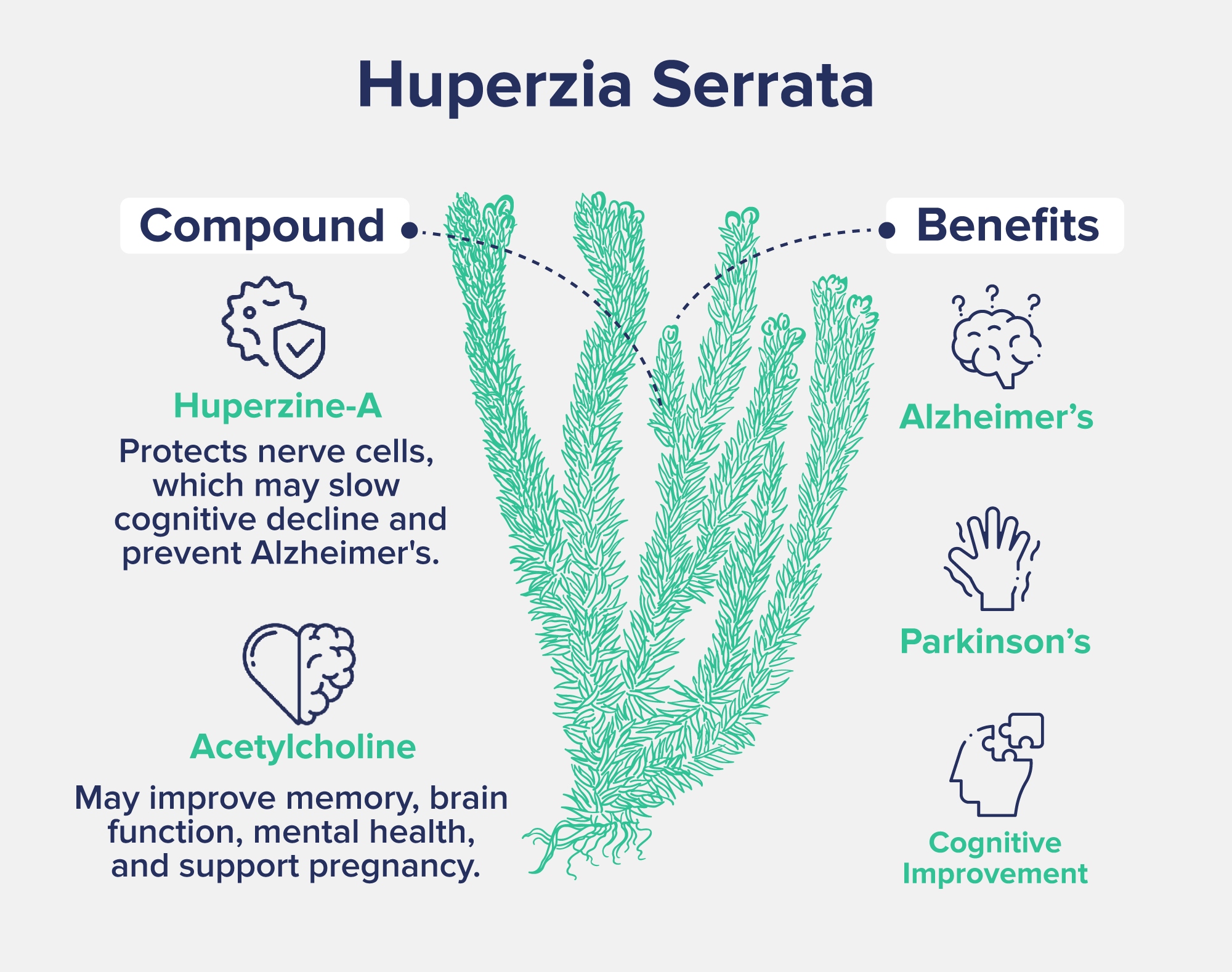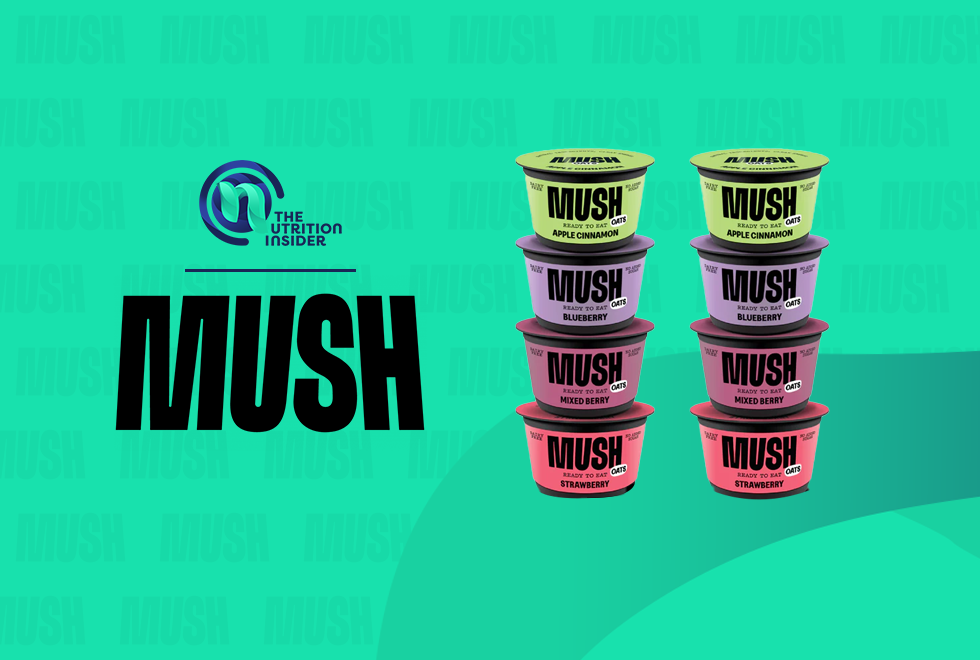This post contains links through which we may earn a small commission should you make a purchase from a brand. This in no way affects our ability to objectively critique the products and brands we review.
Huperzia Serrata: Not Just for Alzheimer’s
Evidence Based Research To fulfill our commitment to bringing our audience accurate and insightful content, our expert writers and medical reviewers rely on carefully curated research.
Read Our Editorial Policy
The mossy, spindly extensions of Huperzia serrata may not look like much to the casual observer, but the compounds therein can improve memory and other cognitive functions for Alzheimer’s patients to potentially great effect.
Moreover, everyone could use a brain boost now and then, which is another reason why this humble moss deserves a much broader introduction than a sentence or two on a supplement label.
In this article, we’ll review the origins and traditional uses of Huperzia serrata, the compounds inside the plant, and how they can help with various disorders affecting the brain.
Where Is Huperzia Serrata From?
Most often classified as a “club moss,” this modest plant is found naturally in various countries to the far east, including Korea, Japan, Taiwan, Indo-China, the Philippines, Haiti, and other countries in these regions.
There is also a secondary population in Mexico and Cuba.
Though the written record doesn’t clearly distinguish which of these countries first inculcated Huperzia serrata into their medical practices, most sources agree that it first appeared in traditional Chinese medicine.
For upwards of a millennia, the Chinese have used the plant as an ingredient in qian ceng ta, an herbal medicine intended for bouts of inflammation, pain, spasms, and other issues.
In 1996, the Chinese solidified the plant’s place in their modernizing (yet still traditional) healthcare paradigm by classifying an active compound within the plant (particularly, huperzine A) as a “new drug” for the management of Alzheimer’s disease symptoms.
The adoption of Huperzia serrata into Western medicine has been an ongoing and markedly slower process, but it has surfaced somewhat prominently in brain-boosting supplements.
Huperzine A and Its Benefits

Both Western and Eastern researchers are continually refining their understanding of Huperzia serrata and the debilitating conditions it can treat.
Before we rattle off the list of purported benefits, it’s important for a greater understanding to have a basic rundown of the active compounds in this plant and their functions.
What’s In This Stuff?
Though the club moss contains a broad range of potentially beneficial compounds known as alkaloids, triterpenoids, and all kinds of -oids, the primary focus for the vast majority of researchers has been huperzine A.
This is because huperzine A, one such compound native to the plant, has proven itself so useful for the treatment of Alzheimer’s-related symptoms, it can even outperform well-established Alzheimer’s drugs.
For example, this finding from Comprehensive Natural Products II, a book of research findings related to herbal compounds, explains that the action of huperzine A has “a major role in the treatment of this devastating disease (Alzheimer’s)…and is more effective than other drugs that affect the cholinergic system and that are currently on the market in the USA for the treatment of mild to moderate AD.”
The key mechanism delivering these benefits is a fickle bit of word salad known as acetylcholinesterase inhibition—never fear, it’s actually pretty simple.
Acetylcholy-who?
One of the major driving forces of Alzheimer’s symptoms is a lack of a key chemical messenger called acetylcholine.
Acetylcholine is an extremely important substance that allows for fluid movement, memory, blood vessel dilation, heart rate regulation, and much more.
The more deficient Alzheimer’s patients are in acetylcholine, the more they will struggle with both cognitive (especially memory) and physical symptoms.
When the “message” is sent between neurons using acetylcholine, an enzyme called acetylcholinesterase comes along to break down the leftover acetylcholine.
This normally routine process is a problem in the Alzheimer’s brain, since it is in dire need of acetylcholine.
Huperzine A has the ability to inhibit the “clean-up enzyme” (acetylcholinesterase), which allows more of this vital chemical messenger to hang around and eventually hit the target receptor again.
The result is improved memory and cognition for Alzheimer’s patients, which is obviously a huge win.
Huperzine A was described in the International Review of Neurobiology, a book series authored by neuroscientists, to protect against free radicals and glutamate, which also have a strong influence on the Alzheimer’s disease process.
But Alzheimer’s isn’t the only application of huperzine A and, to a lesser extent, its neighboring compounds in its native plant.
Here’s what else it can help with.
Parkinson’s Potential
As outlined by this paper from King’s College in London, one major similarity between Alzheimer’s and Parkinson’s disease is consistently low acetylcholine levels.
Though Parkinson’s is also enabled by dopamine deficiency and several other more intricate developments, the researchers explain that acetylcholinesterase inhibitors like Huperzia serrata have encouraged “major advances in the treatment of AD,” though the “use of inhibitors of enzymes (for Parkinson’s) is an avenue which is being explored.”
To date, most clinicians focus more on elevating dopamine levels in Parkinson’s patients with drugs like levodopa than retaining acetylcholine, but as this avenue continues to be explored, the spectrum may change.
It doesn’t have to be thought of as one or the other, either; this study from the Shanghai Institutes for Biological Sciences showed that the increased release of acetylcholine was accompanied by an increased release of dopamine after huperzine A administration.
General Cognitive Improvements
You don’t have to be diagnosed with a potentially debilitating neurodegenerative disease to feel foggy.
No brain is immune to damage from free radicals and/or inflammation.
Since Huperzia serrata has neuroprotective effects against these endemic issues, it can alleviate more minor and/or temporary lapses in memory and cognition caused by stress or fatigue.
Where to Find Huperzia Serrata
As this plant continues to raise eyebrows amongst clinical trial designers in the West and the East, it’s increasing its presence in popular supplements.
If you happen to live in eastern Asia, you just may spy this moss on your next hike.
However, if you’re looking for a carefully crafted supplement that pairs Huperzia serrata with an entire supporting cast of brain-boosting compounds, we highly recommend Alpha Brain from Onnit.

Onnit Alpha Brain
- Description
Alpha Brain is full of brain-boosting ingredients that may help with memory, focus, and more.
- Ingredients
Vitamin B6, Onnit Flow Blend, Onnit Focus Blend (includes Huperzia serrata), Onnit Fuel Blend. Other ingredients: Maltodextrin, Vegetarian Capsule (Hydroxypropyl Methylcellulose, Water), Rice Hull Concentrate (Nu-Flow).Learn more.
As always, we want to remind readers that supplements are supplements; they only do part of the work.
With optimal sleep, exercise, diet, and stress management, you can drastically increase your chances of finding success with a Huperzia serrata product.







